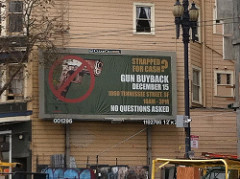Media Reports Australians 'Handed In' 57,000 Guns Last Year; 37,000 of Them Essentially Handed Right Back
Australia's lauded 1996 gun buyback also likely had no real effect on its gun death rates.
The Washington Post tells us today that "As U.S. gun debate rages on, Australians hand in 57,000 firearms."

The story says that Australians "handed over 57,000 illegal firearms between July and September last year during a gun amnesty. In total, more than 35,000 rifles and more than 12,000 shotguns were turned in, among other firearms."
Given the context the Post itself provides—that the U.S. gun debate is now largely about semi-automatic rifles—it's worth noting that, according to the actual "National Firearms Amnesty 2017" report, only 2,417 were semi-automatic weapons, a far smaller number in this "amnesty" than air rifles, accounting for 4,816. (The report says 162 of the "guns" handed in were "imitation.")
That language of the Post headline implies, and nothing in the remainder of either story clarifies further, that citizens in Australia no longer have those 57,000 guns. That is the normal meaning of the phrase "turned in." But as the National Firearms Amnesty report explains, over 37,000 of those guns were merely being officially registered or even sold; only 20,000 of them, around a third of the headline-grabbing number, are actually being taken out of circulation.
In 1996, Australia famously reacted to a mass shooting in Port Arthur by initiating a ban and buyback on many kinds of semi-automatic and other (but by no means all) guns. That ban, like all gun bans, has been widely flouted.
It's understandable that Australia should interest those wondering if legal measures can curb gun violence and deaths. As a 2008 study from the Melbourne Institute (part of the University of Melbourne) on the effects of Australia's gun control measures after Port Arthur started by noting that
Australia's 1996-97 National Firearms Agreement (NFA), which involved the buyback and destruction of over 600,000 guns within a few months, is one of the most massive government adjustments to gun control regulations in the developed world in recent history. The extent of the buyback and accompanying swift nationwide change in the firearm regulatory environment following the enactment of the NFA (prohibition on certain types of firearms, registration requirements etc.) makes this policy a natural experiment in which the results of a methodical evaluation would be extremely interesting…
And their rough conclusion?
Despite the fact that several researchers using the same data have examined the impact of the NFA on firearm deaths, a consensus does not appear to have been reached. In this paper, we re-analyze the same data on firearm deaths used in previous research, using tests for unknown structural breaks as a means to identifying impacts of the NFA. The results of these tests suggest that the NFA did not have any large effects on reducing firearm homicide or suicide rates.
The authors came to this conclusion after examining, using a variety of statistical techniques, nearly a century of homicide and suicide data, gun and non-gun, looking for "structural break points" that would indicate some policy or other change was clearly affecting the rates. They did not find any for any period around or after the NFA.
They concluded, "Although gun buybacks appear to be a logical and sensible policy that helps to placate the public's fears, the evidence so far suggests that in the Australian context, the high expenditure incurred to fund the 1996 gun buyback has not translated into any tangible reductions in terms of firearm deaths."
Those who imagine Australia just manned up and removed any means for Australians to harm each other with guns should also note that Small Arms Survey data from 2007 (the last year the organization seems to have attempted a full world survey of civilian arms ownership) had Australia ranked number 26 among the nations of the world in terms of total civilian firearm ownership. It is quite misleading for Americans to assume that "buyback" means "a nation without guns," or even "a nation without lots and lots of guns in private hands." Over 3 million such remained according to that survey, around 16 per 100 people.
A 2006 Injury Prevention study finds a decline in firearm homicides had already begun in Australia before the buyback. It also finds that the decline in percentage terms did increase post-buyback. The study said "the rate of firearm homicide was reducing by an average of 3% per year, [and] this increased to 7.5% per year after the introduction of gun laws. However, the ratio of trend estimates failed to reach statistical significance (p?=?0.15) because of the low power inherent in the small numbers involved."
At any rate, the study also says, "conclusions regarding causality of the association must remain interpretive rather than definitive."
Knowing that one element caused another rather than just being associated with it is always going to be tricky and undefinitive with the best possible information and social science correlation techniques. If that sounds absurd to you—why, of course if the firearm homicide rate went down in a countable even if non-"statistically significant" way after such a major change in law, the law deserves credit—it's worth looking at a country that ranks number one in civilian firearm ownership, has had no comparable buyback attempted, and also saw its firearm homicide rate fall by half in the two decades from 1993 to 2013. That country is, of course, the United States.
We have, then, seen dives in Western nation firearm homicides that had nothing to do with anything like a buyback. To conclude Australia's diminution in gun deaths was caused by that buyback and would not or could not have happened without it is to conclude more than available facts support.




Show Comments (107)